An Analysis of Growth and Development in Early Childhood: Report
VerifiedAdded on 2022/08/28
|11
|2790
|17
Report
AI Summary
This report delves into the multifaceted realm of child growth and development, examining the interplay between physical, mental, and social aspects. It begins by defining growth and development, highlighting their interconnectedness and the significance of early childhood experiences. The report explores various influential theories, including psychosexual, psychosocial, child development, cognitive development, attachment, social learning, and sociocultural theories, providing insights into the factors shaping a child's development. It emphasizes the importance of nutrition, environmental factors, and the role of caregivers in fostering healthy growth. The report also discusses the guidelines set by the Australian government for parents regarding activities for children of different age groups and the significance of learning through play and the impact of the child's environment. It underscores the importance of relationships, both within the family and with extended family members and caregivers, in shaping a child's mental and emotional development. Furthermore, the report highlights the critical role of macro and micronutrients in supporting physical and cognitive growth, addressing potential deficiencies and their impact on behavior. Overall, the report underscores the holistic nature of child development and the importance of providing children with supportive environments and appropriate resources to thrive.
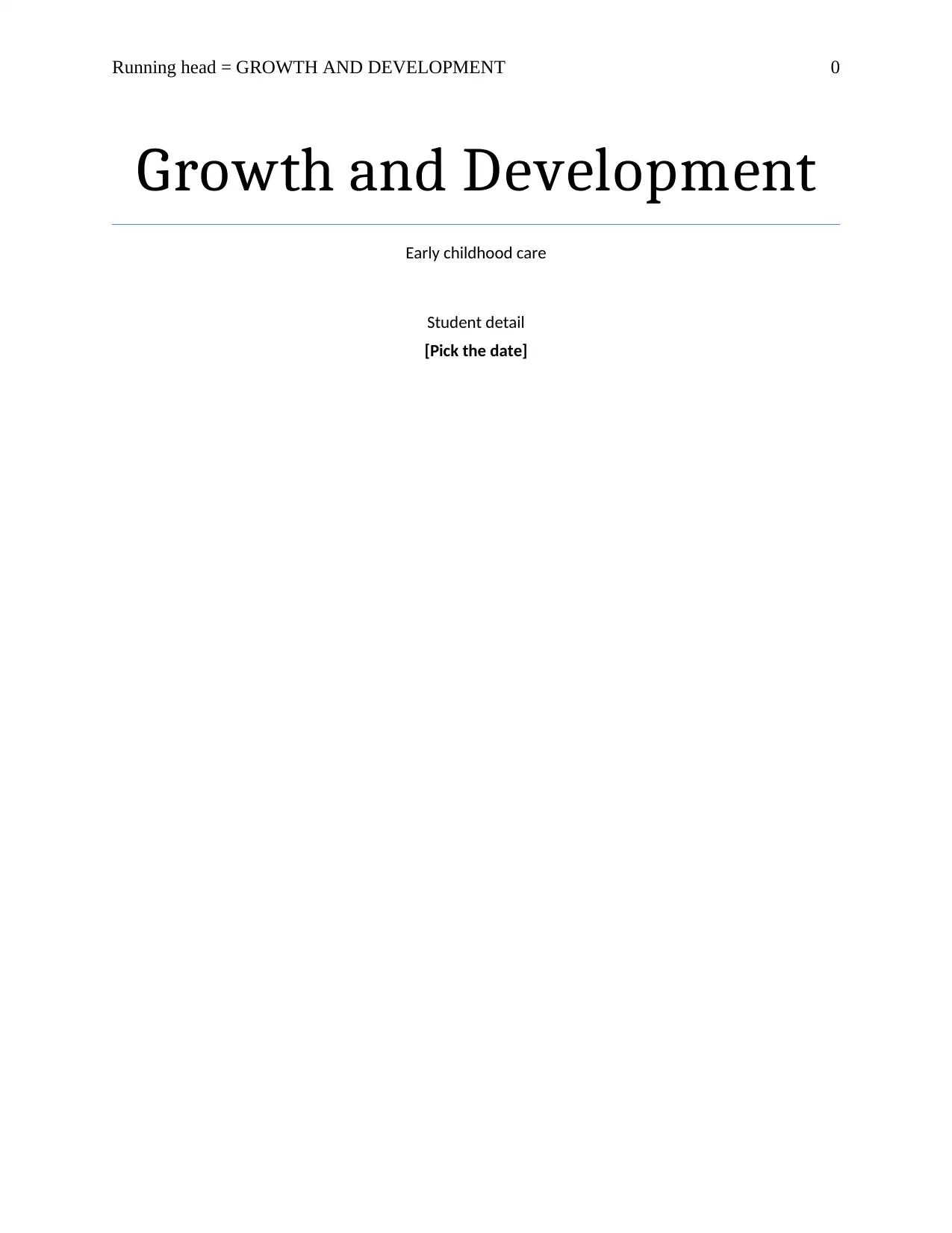
Running head = GROWTH AND DEVELOPMENT 0
Growth and Development
Early childhood care
Student detail
[Pick the date]
Growth and Development
Early childhood care
Student detail
[Pick the date]
Paraphrase This Document
Need a fresh take? Get an instant paraphrase of this document with our AI Paraphraser
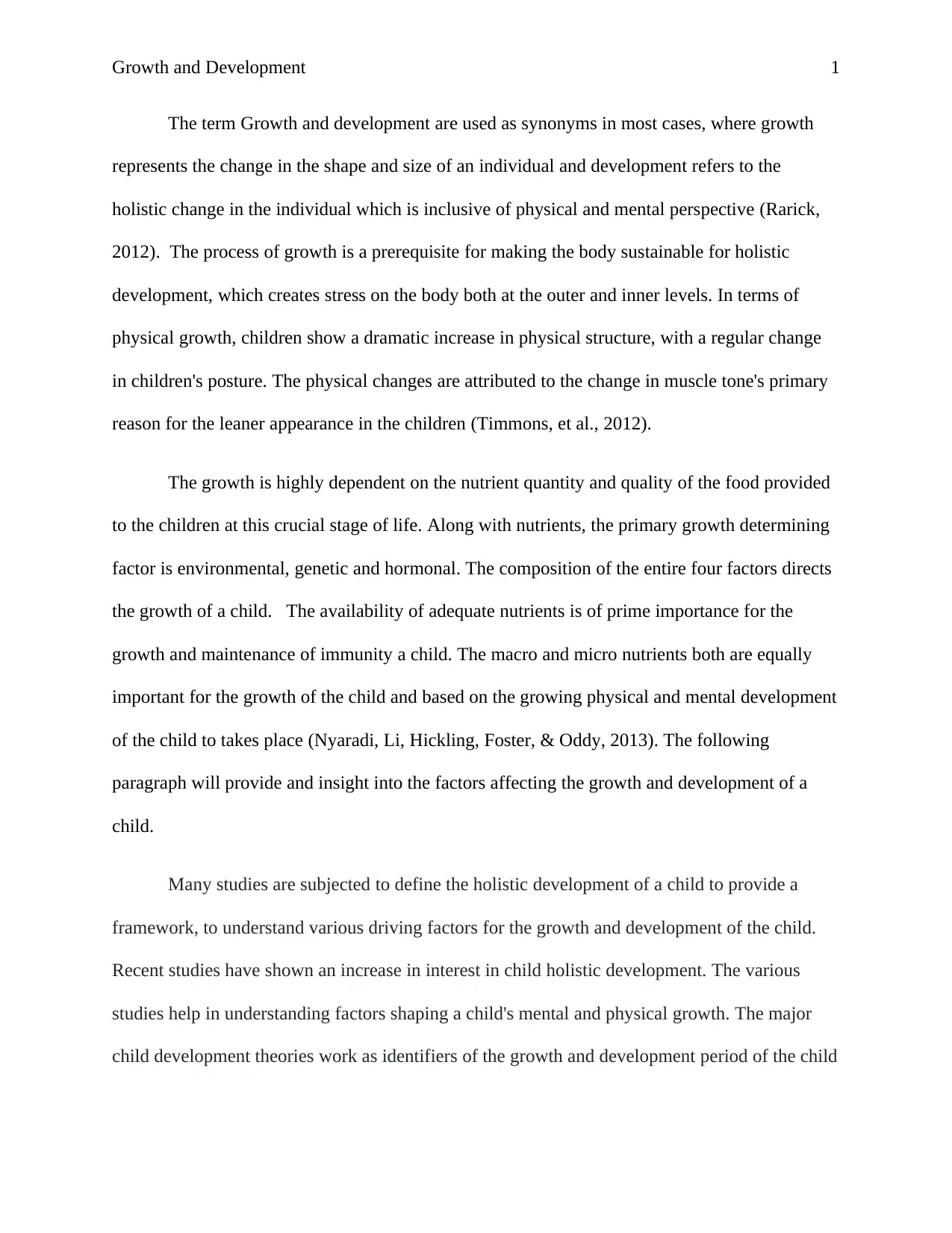
Growth and Development 1
The term Growth and development are used as synonyms in most cases, where growth
represents the change in the shape and size of an individual and development refers to the
holistic change in the individual which is inclusive of physical and mental perspective (Rarick,
2012). The process of growth is a prerequisite for making the body sustainable for holistic
development, which creates stress on the body both at the outer and inner levels. In terms of
physical growth, children show a dramatic increase in physical structure, with a regular change
in children's posture. The physical changes are attributed to the change in muscle tone's primary
reason for the leaner appearance in the children (Timmons, et al., 2012).
The growth is highly dependent on the nutrient quantity and quality of the food provided
to the children at this crucial stage of life. Along with nutrients, the primary growth determining
factor is environmental, genetic and hormonal. The composition of the entire four factors directs
the growth of a child. The availability of adequate nutrients is of prime importance for the
growth and maintenance of immunity a child. The macro and micro nutrients both are equally
important for the growth of the child and based on the growing physical and mental development
of the child to takes place (Nyaradi, Li, Hickling, Foster, & Oddy, 2013). The following
paragraph will provide and insight into the factors affecting the growth and development of a
child.
Many studies are subjected to define the holistic development of a child to provide a
framework, to understand various driving factors for the growth and development of the child.
Recent studies have shown an increase in interest in child holistic development. The various
studies help in understanding factors shaping a child's mental and physical growth. The major
child development theories work as identifiers of the growth and development period of the child
The term Growth and development are used as synonyms in most cases, where growth
represents the change in the shape and size of an individual and development refers to the
holistic change in the individual which is inclusive of physical and mental perspective (Rarick,
2012). The process of growth is a prerequisite for making the body sustainable for holistic
development, which creates stress on the body both at the outer and inner levels. In terms of
physical growth, children show a dramatic increase in physical structure, with a regular change
in children's posture. The physical changes are attributed to the change in muscle tone's primary
reason for the leaner appearance in the children (Timmons, et al., 2012).
The growth is highly dependent on the nutrient quantity and quality of the food provided
to the children at this crucial stage of life. Along with nutrients, the primary growth determining
factor is environmental, genetic and hormonal. The composition of the entire four factors directs
the growth of a child. The availability of adequate nutrients is of prime importance for the
growth and maintenance of immunity a child. The macro and micro nutrients both are equally
important for the growth of the child and based on the growing physical and mental development
of the child to takes place (Nyaradi, Li, Hickling, Foster, & Oddy, 2013). The following
paragraph will provide and insight into the factors affecting the growth and development of a
child.
Many studies are subjected to define the holistic development of a child to provide a
framework, to understand various driving factors for the growth and development of the child.
Recent studies have shown an increase in interest in child holistic development. The various
studies help in understanding factors shaping a child's mental and physical growth. The major
child development theories work as identifiers of the growth and development period of the child
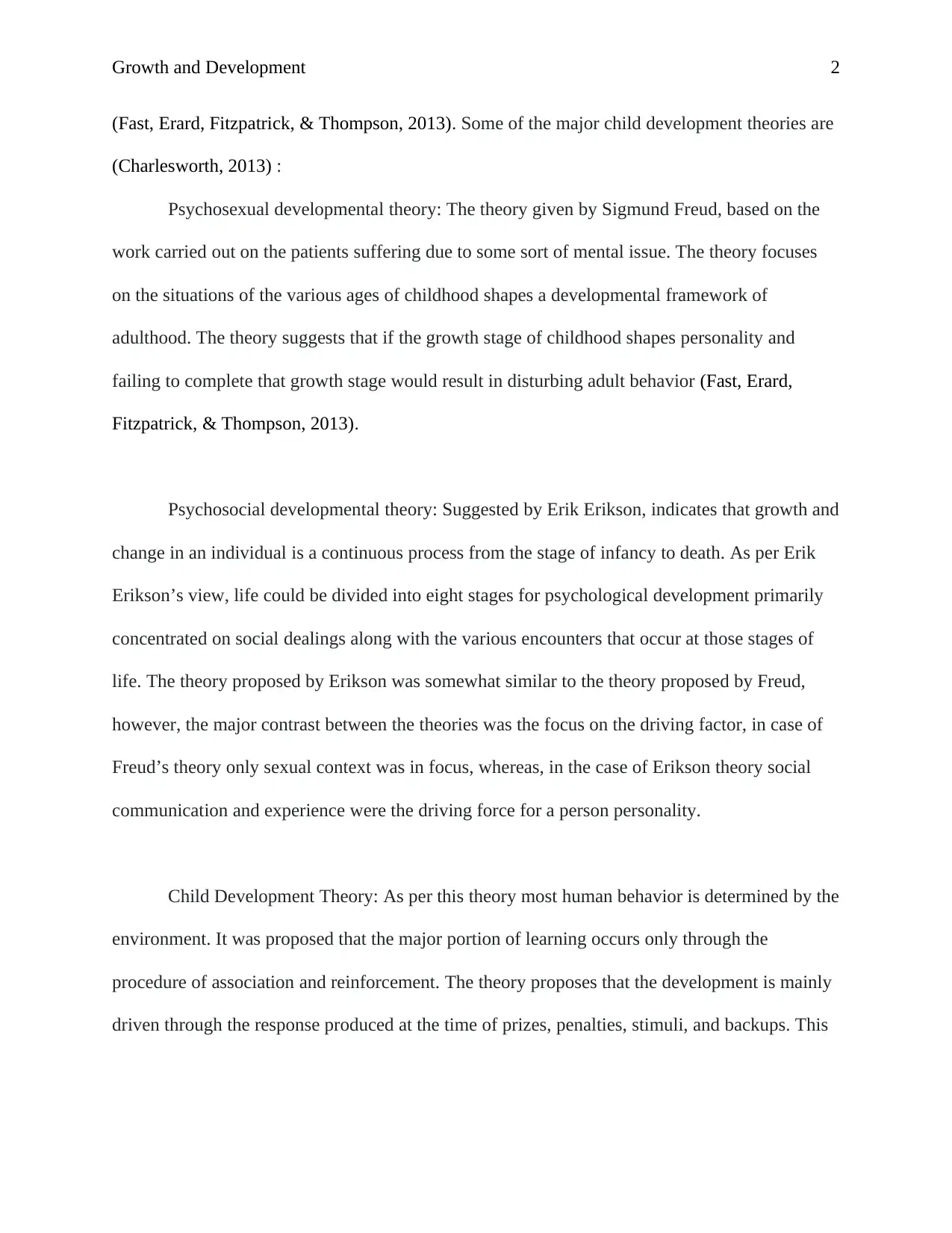
Growth and Development 2
(Fast, Erard, Fitzpatrick, & Thompson, 2013). Some of the major child development theories are
(Charlesworth, 2013) :
Psychosexual developmental theory: The theory given by Sigmund Freud, based on the
work carried out on the patients suffering due to some sort of mental issue. The theory focuses
on the situations of the various ages of childhood shapes a developmental framework of
adulthood. The theory suggests that if the growth stage of childhood shapes personality and
failing to complete that growth stage would result in disturbing adult behavior (Fast, Erard,
Fitzpatrick, & Thompson, 2013).
Psychosocial developmental theory: Suggested by Erik Erikson, indicates that growth and
change in an individual is a continuous process from the stage of infancy to death. As per Erik
Erikson’s view, life could be divided into eight stages for psychological development primarily
concentrated on social dealings along with the various encounters that occur at those stages of
life. The theory proposed by Erikson was somewhat similar to the theory proposed by Freud,
however, the major contrast between the theories was the focus on the driving factor, in case of
Freud’s theory only sexual context was in focus, whereas, in the case of Erikson theory social
communication and experience were the driving force for a person personality.
Child Development Theory: As per this theory most human behavior is determined by the
environment. It was proposed that the major portion of learning occurs only through the
procedure of association and reinforcement. The theory proposes that the development is mainly
driven through the response produced at the time of prizes, penalties, stimuli, and backups. This
(Fast, Erard, Fitzpatrick, & Thompson, 2013). Some of the major child development theories are
(Charlesworth, 2013) :
Psychosexual developmental theory: The theory given by Sigmund Freud, based on the
work carried out on the patients suffering due to some sort of mental issue. The theory focuses
on the situations of the various ages of childhood shapes a developmental framework of
adulthood. The theory suggests that if the growth stage of childhood shapes personality and
failing to complete that growth stage would result in disturbing adult behavior (Fast, Erard,
Fitzpatrick, & Thompson, 2013).
Psychosocial developmental theory: Suggested by Erik Erikson, indicates that growth and
change in an individual is a continuous process from the stage of infancy to death. As per Erik
Erikson’s view, life could be divided into eight stages for psychological development primarily
concentrated on social dealings along with the various encounters that occur at those stages of
life. The theory proposed by Erikson was somewhat similar to the theory proposed by Freud,
however, the major contrast between the theories was the focus on the driving factor, in case of
Freud’s theory only sexual context was in focus, whereas, in the case of Erikson theory social
communication and experience were the driving force for a person personality.
Child Development Theory: As per this theory most human behavior is determined by the
environment. It was proposed that the major portion of learning occurs only through the
procedure of association and reinforcement. The theory proposes that the development is mainly
driven through the response produced at the time of prizes, penalties, stimuli, and backups. This
⊘ This is a preview!⊘
Do you want full access?
Subscribe today to unlock all pages.

Trusted by 1+ million students worldwide
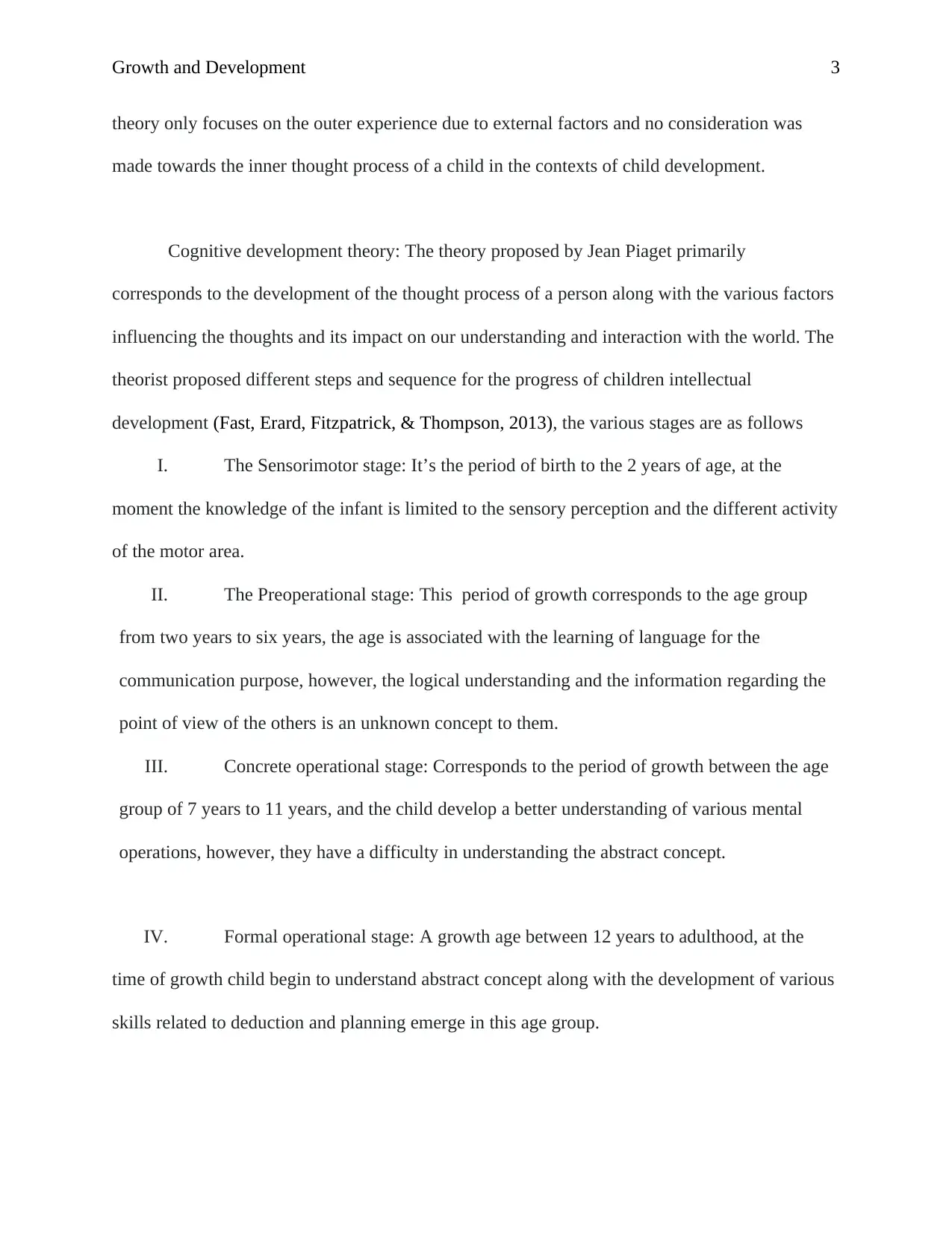
Growth and Development 3
theory only focuses on the outer experience due to external factors and no consideration was
made towards the inner thought process of a child in the contexts of child development.
Cognitive development theory: The theory proposed by Jean Piaget primarily
corresponds to the development of the thought process of a person along with the various factors
influencing the thoughts and its impact on our understanding and interaction with the world. The
theorist proposed different steps and sequence for the progress of children intellectual
development (Fast, Erard, Fitzpatrick, & Thompson, 2013), the various stages are as follows
I. The Sensorimotor stage: It’s the period of birth to the 2 years of age, at the
moment the knowledge of the infant is limited to the sensory perception and the different activity
of the motor area.
II. The Preoperational stage: This period of growth corresponds to the age group
from two years to six years, the age is associated with the learning of language for the
communication purpose, however, the logical understanding and the information regarding the
point of view of the others is an unknown concept to them.
III. Concrete operational stage: Corresponds to the period of growth between the age
group of 7 years to 11 years, and the child develop a better understanding of various mental
operations, however, they have a difficulty in understanding the abstract concept.
IV. Formal operational stage: A growth age between 12 years to adulthood, at the
time of growth child begin to understand abstract concept along with the development of various
skills related to deduction and planning emerge in this age group.
theory only focuses on the outer experience due to external factors and no consideration was
made towards the inner thought process of a child in the contexts of child development.
Cognitive development theory: The theory proposed by Jean Piaget primarily
corresponds to the development of the thought process of a person along with the various factors
influencing the thoughts and its impact on our understanding and interaction with the world. The
theorist proposed different steps and sequence for the progress of children intellectual
development (Fast, Erard, Fitzpatrick, & Thompson, 2013), the various stages are as follows
I. The Sensorimotor stage: It’s the period of birth to the 2 years of age, at the
moment the knowledge of the infant is limited to the sensory perception and the different activity
of the motor area.
II. The Preoperational stage: This period of growth corresponds to the age group
from two years to six years, the age is associated with the learning of language for the
communication purpose, however, the logical understanding and the information regarding the
point of view of the others is an unknown concept to them.
III. Concrete operational stage: Corresponds to the period of growth between the age
group of 7 years to 11 years, and the child develop a better understanding of various mental
operations, however, they have a difficulty in understanding the abstract concept.
IV. Formal operational stage: A growth age between 12 years to adulthood, at the
time of growth child begin to understand abstract concept along with the development of various
skills related to deduction and planning emerge in this age group.
Paraphrase This Document
Need a fresh take? Get an instant paraphrase of this document with our AI Paraphraser
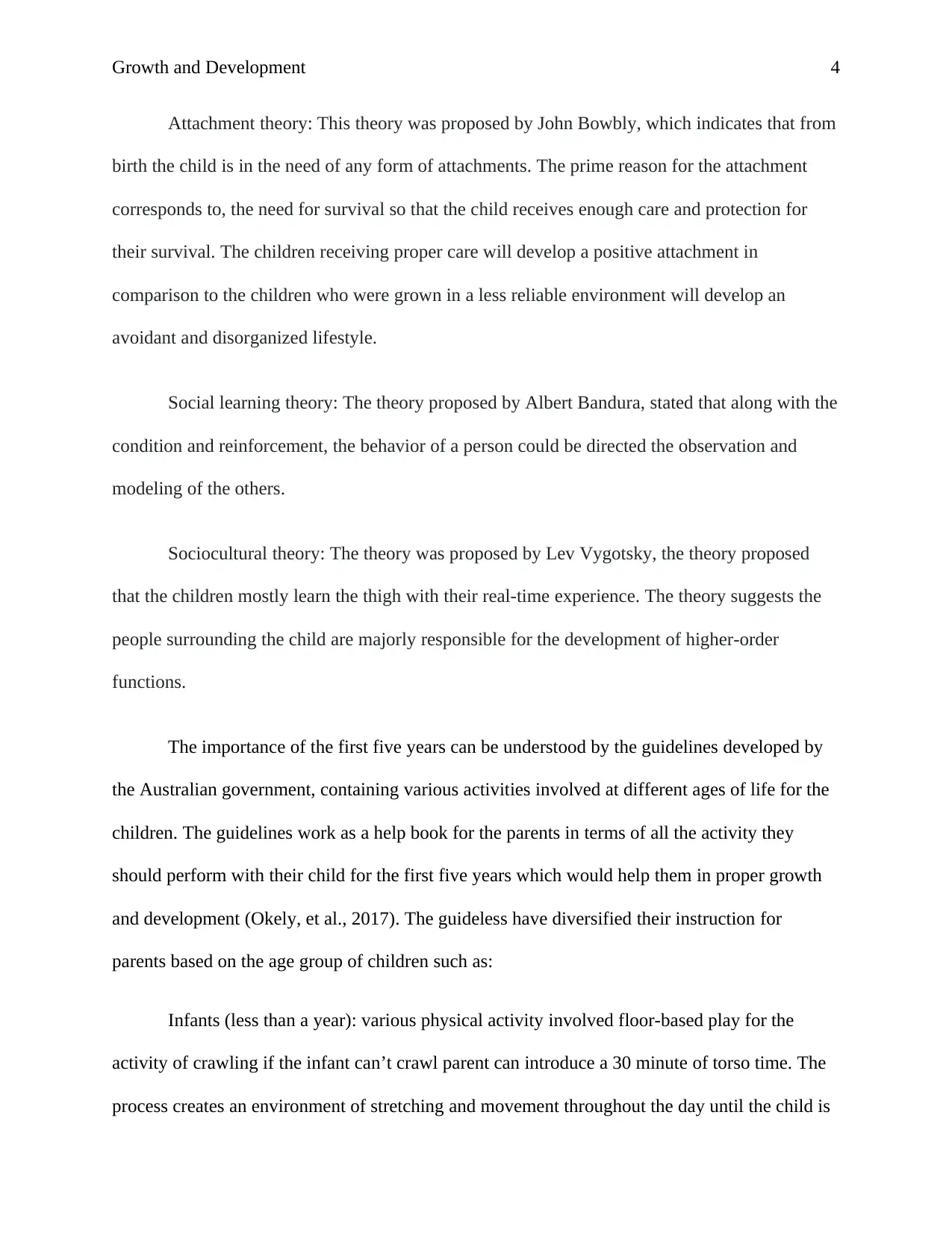
Growth and Development 4
Attachment theory: This theory was proposed by John Bowbly, which indicates that from
birth the child is in the need of any form of attachments. The prime reason for the attachment
corresponds to, the need for survival so that the child receives enough care and protection for
their survival. The children receiving proper care will develop a positive attachment in
comparison to the children who were grown in a less reliable environment will develop an
avoidant and disorganized lifestyle.
Social learning theory: The theory proposed by Albert Bandura, stated that along with the
condition and reinforcement, the behavior of a person could be directed the observation and
modeling of the others.
Sociocultural theory: The theory was proposed by Lev Vygotsky, the theory proposed
that the children mostly learn the thigh with their real-time experience. The theory suggests the
people surrounding the child are majorly responsible for the development of higher-order
functions.
The importance of the first five years can be understood by the guidelines developed by
the Australian government, containing various activities involved at different ages of life for the
children. The guidelines work as a help book for the parents in terms of all the activity they
should perform with their child for the first five years which would help them in proper growth
and development (Okely, et al., 2017). The guideless have diversified their instruction for
parents based on the age group of children such as:
Infants (less than a year): various physical activity involved floor-based play for the
activity of crawling if the infant can’t crawl parent can introduce a 30 minute of torso time. The
process creates an environment of stretching and movement throughout the day until the child is
Attachment theory: This theory was proposed by John Bowbly, which indicates that from
birth the child is in the need of any form of attachments. The prime reason for the attachment
corresponds to, the need for survival so that the child receives enough care and protection for
their survival. The children receiving proper care will develop a positive attachment in
comparison to the children who were grown in a less reliable environment will develop an
avoidant and disorganized lifestyle.
Social learning theory: The theory proposed by Albert Bandura, stated that along with the
condition and reinforcement, the behavior of a person could be directed the observation and
modeling of the others.
Sociocultural theory: The theory was proposed by Lev Vygotsky, the theory proposed
that the children mostly learn the thigh with their real-time experience. The theory suggests the
people surrounding the child are majorly responsible for the development of higher-order
functions.
The importance of the first five years can be understood by the guidelines developed by
the Australian government, containing various activities involved at different ages of life for the
children. The guidelines work as a help book for the parents in terms of all the activity they
should perform with their child for the first five years which would help them in proper growth
and development (Okely, et al., 2017). The guideless have diversified their instruction for
parents based on the age group of children such as:
Infants (less than a year): various physical activity involved floor-based play for the
activity of crawling if the infant can’t crawl parent can introduce a 30 minute of torso time. The
process creates an environment of stretching and movement throughout the day until the child is
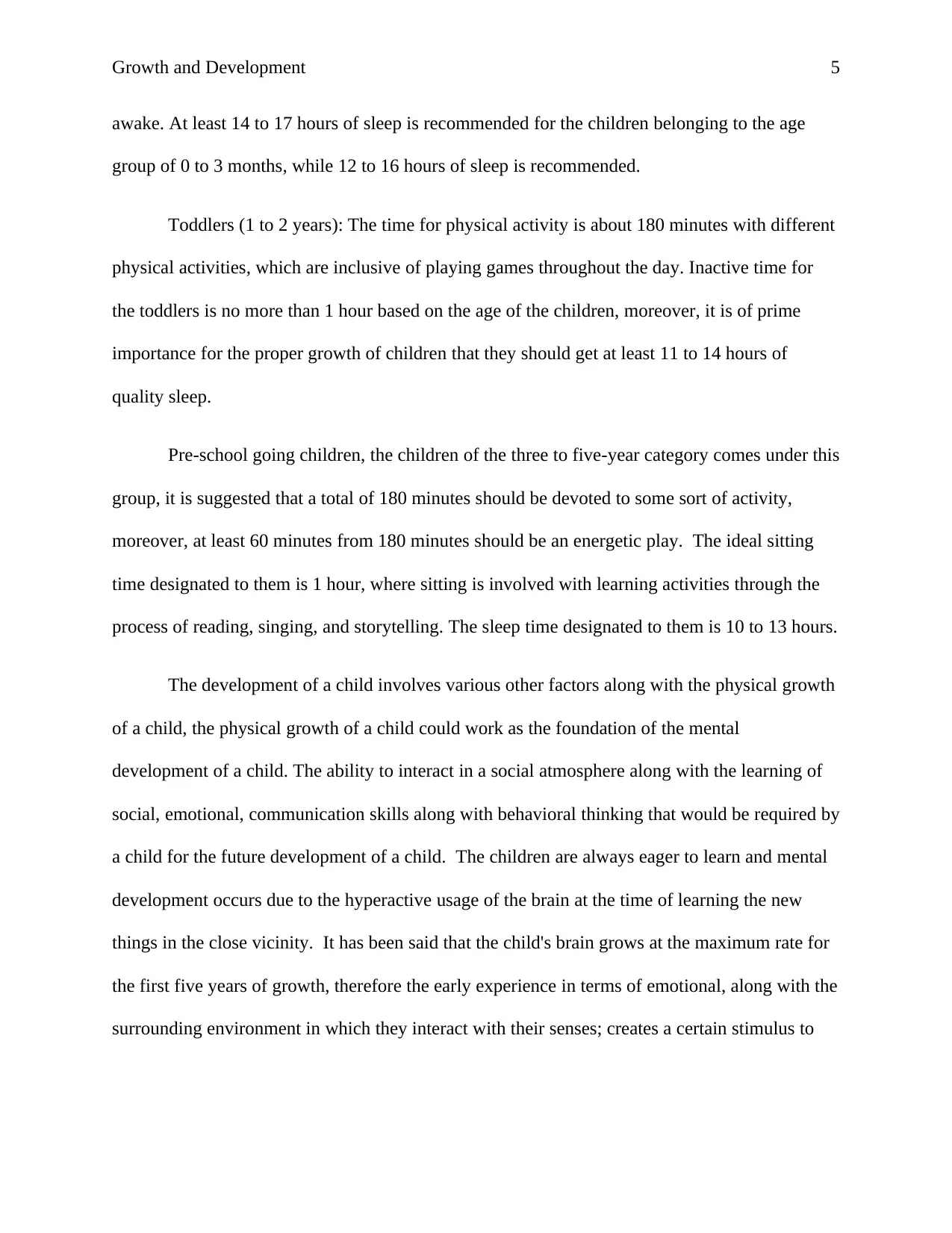
Growth and Development 5
awake. At least 14 to 17 hours of sleep is recommended for the children belonging to the age
group of 0 to 3 months, while 12 to 16 hours of sleep is recommended.
Toddlers (1 to 2 years): The time for physical activity is about 180 minutes with different
physical activities, which are inclusive of playing games throughout the day. Inactive time for
the toddlers is no more than 1 hour based on the age of the children, moreover, it is of prime
importance for the proper growth of children that they should get at least 11 to 14 hours of
quality sleep.
Pre-school going children, the children of the three to five-year category comes under this
group, it is suggested that a total of 180 minutes should be devoted to some sort of activity,
moreover, at least 60 minutes from 180 minutes should be an energetic play. The ideal sitting
time designated to them is 1 hour, where sitting is involved with learning activities through the
process of reading, singing, and storytelling. The sleep time designated to them is 10 to 13 hours.
The development of a child involves various other factors along with the physical growth
of a child, the physical growth of a child could work as the foundation of the mental
development of a child. The ability to interact in a social atmosphere along with the learning of
social, emotional, communication skills along with behavioral thinking that would be required by
a child for the future development of a child. The children are always eager to learn and mental
development occurs due to the hyperactive usage of the brain at the time of learning the new
things in the close vicinity. It has been said that the child's brain grows at the maximum rate for
the first five years of growth, therefore the early experience in terms of emotional, along with the
surrounding environment in which they interact with their senses; creates a certain stimulus to
awake. At least 14 to 17 hours of sleep is recommended for the children belonging to the age
group of 0 to 3 months, while 12 to 16 hours of sleep is recommended.
Toddlers (1 to 2 years): The time for physical activity is about 180 minutes with different
physical activities, which are inclusive of playing games throughout the day. Inactive time for
the toddlers is no more than 1 hour based on the age of the children, moreover, it is of prime
importance for the proper growth of children that they should get at least 11 to 14 hours of
quality sleep.
Pre-school going children, the children of the three to five-year category comes under this
group, it is suggested that a total of 180 minutes should be devoted to some sort of activity,
moreover, at least 60 minutes from 180 minutes should be an energetic play. The ideal sitting
time designated to them is 1 hour, where sitting is involved with learning activities through the
process of reading, singing, and storytelling. The sleep time designated to them is 10 to 13 hours.
The development of a child involves various other factors along with the physical growth
of a child, the physical growth of a child could work as the foundation of the mental
development of a child. The ability to interact in a social atmosphere along with the learning of
social, emotional, communication skills along with behavioral thinking that would be required by
a child for the future development of a child. The children are always eager to learn and mental
development occurs due to the hyperactive usage of the brain at the time of learning the new
things in the close vicinity. It has been said that the child's brain grows at the maximum rate for
the first five years of growth, therefore the early experience in terms of emotional, along with the
surrounding environment in which they interact with their senses; creates a certain stimulus to
⊘ This is a preview!⊘
Do you want full access?
Subscribe today to unlock all pages.

Trusted by 1+ million students worldwide
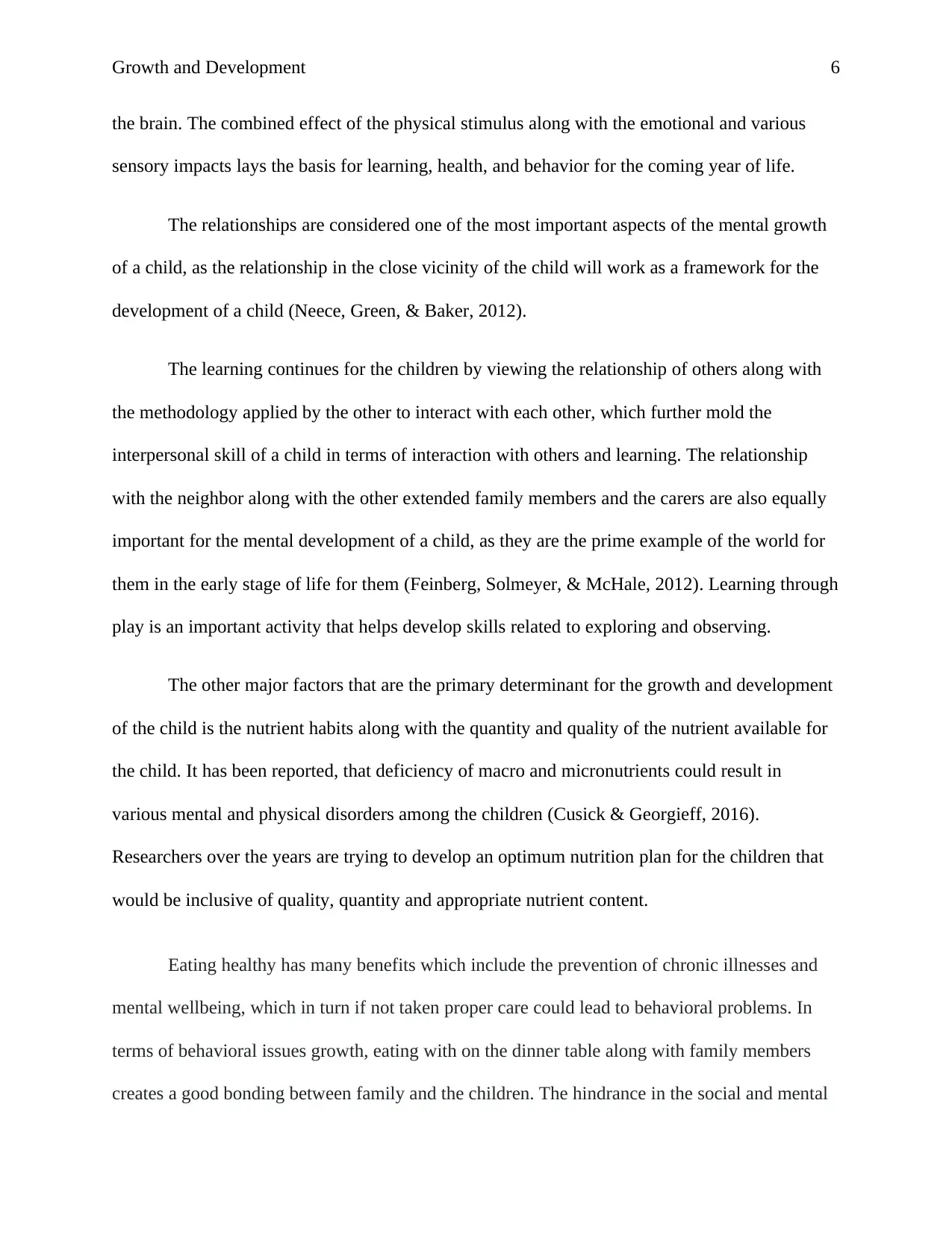
Growth and Development 6
the brain. The combined effect of the physical stimulus along with the emotional and various
sensory impacts lays the basis for learning, health, and behavior for the coming year of life.
The relationships are considered one of the most important aspects of the mental growth
of a child, as the relationship in the close vicinity of the child will work as a framework for the
development of a child (Neece, Green, & Baker, 2012).
The learning continues for the children by viewing the relationship of others along with
the methodology applied by the other to interact with each other, which further mold the
interpersonal skill of a child in terms of interaction with others and learning. The relationship
with the neighbor along with the other extended family members and the carers are also equally
important for the mental development of a child, as they are the prime example of the world for
them in the early stage of life for them (Feinberg, Solmeyer, & McHale, 2012). Learning through
play is an important activity that helps develop skills related to exploring and observing.
The other major factors that are the primary determinant for the growth and development
of the child is the nutrient habits along with the quantity and quality of the nutrient available for
the child. It has been reported, that deficiency of macro and micronutrients could result in
various mental and physical disorders among the children (Cusick & Georgieff, 2016).
Researchers over the years are trying to develop an optimum nutrition plan for the children that
would be inclusive of quality, quantity and appropriate nutrient content.
Eating healthy has many benefits which include the prevention of chronic illnesses and
mental wellbeing, which in turn if not taken proper care could lead to behavioral problems. In
terms of behavioral issues growth, eating with on the dinner table along with family members
creates a good bonding between family and the children. The hindrance in the social and mental
the brain. The combined effect of the physical stimulus along with the emotional and various
sensory impacts lays the basis for learning, health, and behavior for the coming year of life.
The relationships are considered one of the most important aspects of the mental growth
of a child, as the relationship in the close vicinity of the child will work as a framework for the
development of a child (Neece, Green, & Baker, 2012).
The learning continues for the children by viewing the relationship of others along with
the methodology applied by the other to interact with each other, which further mold the
interpersonal skill of a child in terms of interaction with others and learning. The relationship
with the neighbor along with the other extended family members and the carers are also equally
important for the mental development of a child, as they are the prime example of the world for
them in the early stage of life for them (Feinberg, Solmeyer, & McHale, 2012). Learning through
play is an important activity that helps develop skills related to exploring and observing.
The other major factors that are the primary determinant for the growth and development
of the child is the nutrient habits along with the quantity and quality of the nutrient available for
the child. It has been reported, that deficiency of macro and micronutrients could result in
various mental and physical disorders among the children (Cusick & Georgieff, 2016).
Researchers over the years are trying to develop an optimum nutrition plan for the children that
would be inclusive of quality, quantity and appropriate nutrient content.
Eating healthy has many benefits which include the prevention of chronic illnesses and
mental wellbeing, which in turn if not taken proper care could lead to behavioral problems. In
terms of behavioral issues growth, eating with on the dinner table along with family members
creates a good bonding between family and the children. The hindrance in the social and mental
Paraphrase This Document
Need a fresh take? Get an instant paraphrase of this document with our AI Paraphraser
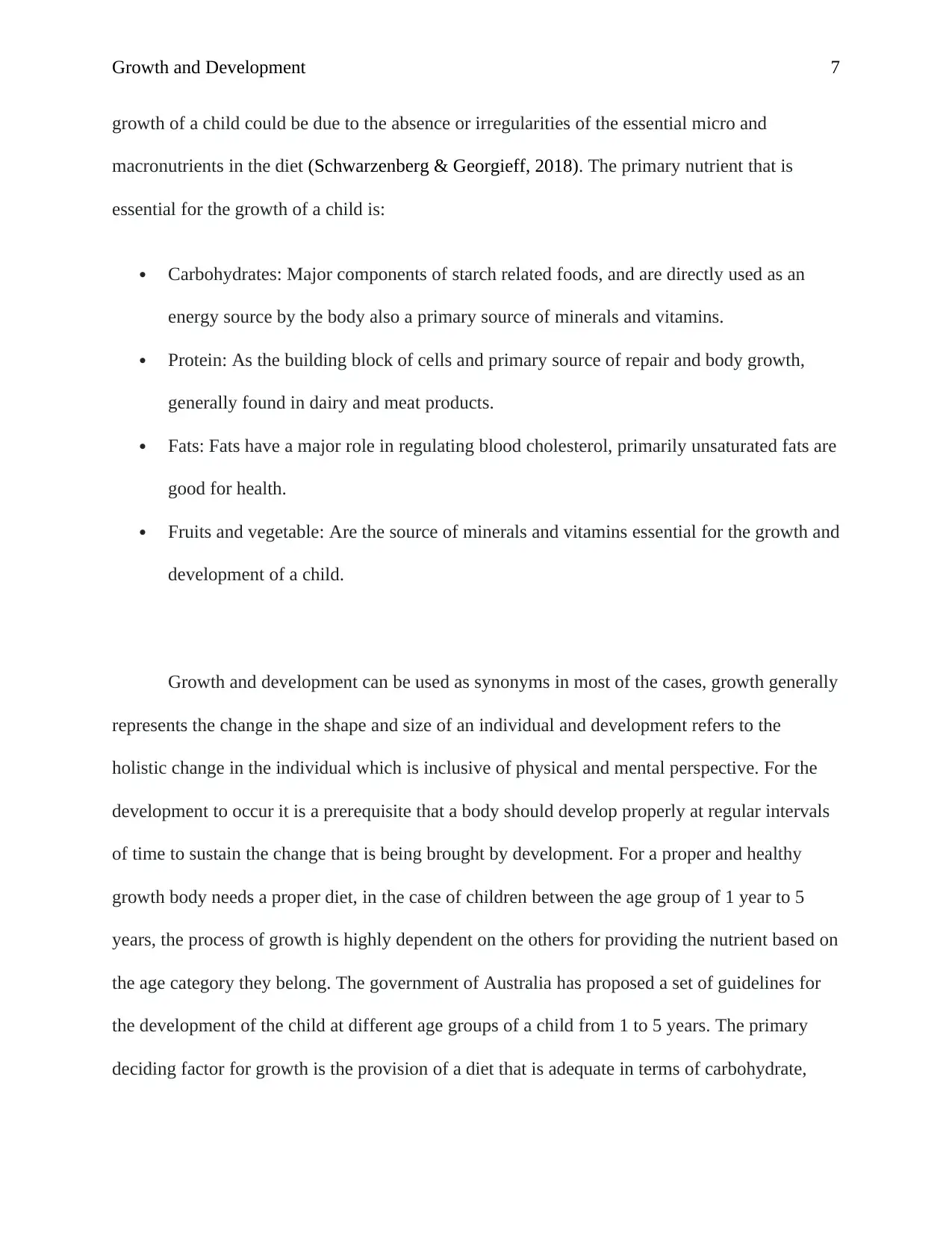
Growth and Development 7
growth of a child could be due to the absence or irregularities of the essential micro and
macronutrients in the diet (Schwarzenberg & Georgieff, 2018). The primary nutrient that is
essential for the growth of a child is:
Carbohydrates: Major components of starch related foods, and are directly used as an
energy source by the body also a primary source of minerals and vitamins.
Protein: As the building block of cells and primary source of repair and body growth,
generally found in dairy and meat products.
Fats: Fats have a major role in regulating blood cholesterol, primarily unsaturated fats are
good for health.
Fruits and vegetable: Are the source of minerals and vitamins essential for the growth and
development of a child.
Growth and development can be used as synonyms in most of the cases, growth generally
represents the change in the shape and size of an individual and development refers to the
holistic change in the individual which is inclusive of physical and mental perspective. For the
development to occur it is a prerequisite that a body should develop properly at regular intervals
of time to sustain the change that is being brought by development. For a proper and healthy
growth body needs a proper diet, in the case of children between the age group of 1 year to 5
years, the process of growth is highly dependent on the others for providing the nutrient based on
the age category they belong. The government of Australia has proposed a set of guidelines for
the development of the child at different age groups of a child from 1 to 5 years. The primary
deciding factor for growth is the provision of a diet that is adequate in terms of carbohydrate,
growth of a child could be due to the absence or irregularities of the essential micro and
macronutrients in the diet (Schwarzenberg & Georgieff, 2018). The primary nutrient that is
essential for the growth of a child is:
Carbohydrates: Major components of starch related foods, and are directly used as an
energy source by the body also a primary source of minerals and vitamins.
Protein: As the building block of cells and primary source of repair and body growth,
generally found in dairy and meat products.
Fats: Fats have a major role in regulating blood cholesterol, primarily unsaturated fats are
good for health.
Fruits and vegetable: Are the source of minerals and vitamins essential for the growth and
development of a child.
Growth and development can be used as synonyms in most of the cases, growth generally
represents the change in the shape and size of an individual and development refers to the
holistic change in the individual which is inclusive of physical and mental perspective. For the
development to occur it is a prerequisite that a body should develop properly at regular intervals
of time to sustain the change that is being brought by development. For a proper and healthy
growth body needs a proper diet, in the case of children between the age group of 1 year to 5
years, the process of growth is highly dependent on the others for providing the nutrient based on
the age category they belong. The government of Australia has proposed a set of guidelines for
the development of the child at different age groups of a child from 1 to 5 years. The primary
deciding factor for growth is the provision of a diet that is adequate in terms of carbohydrate,
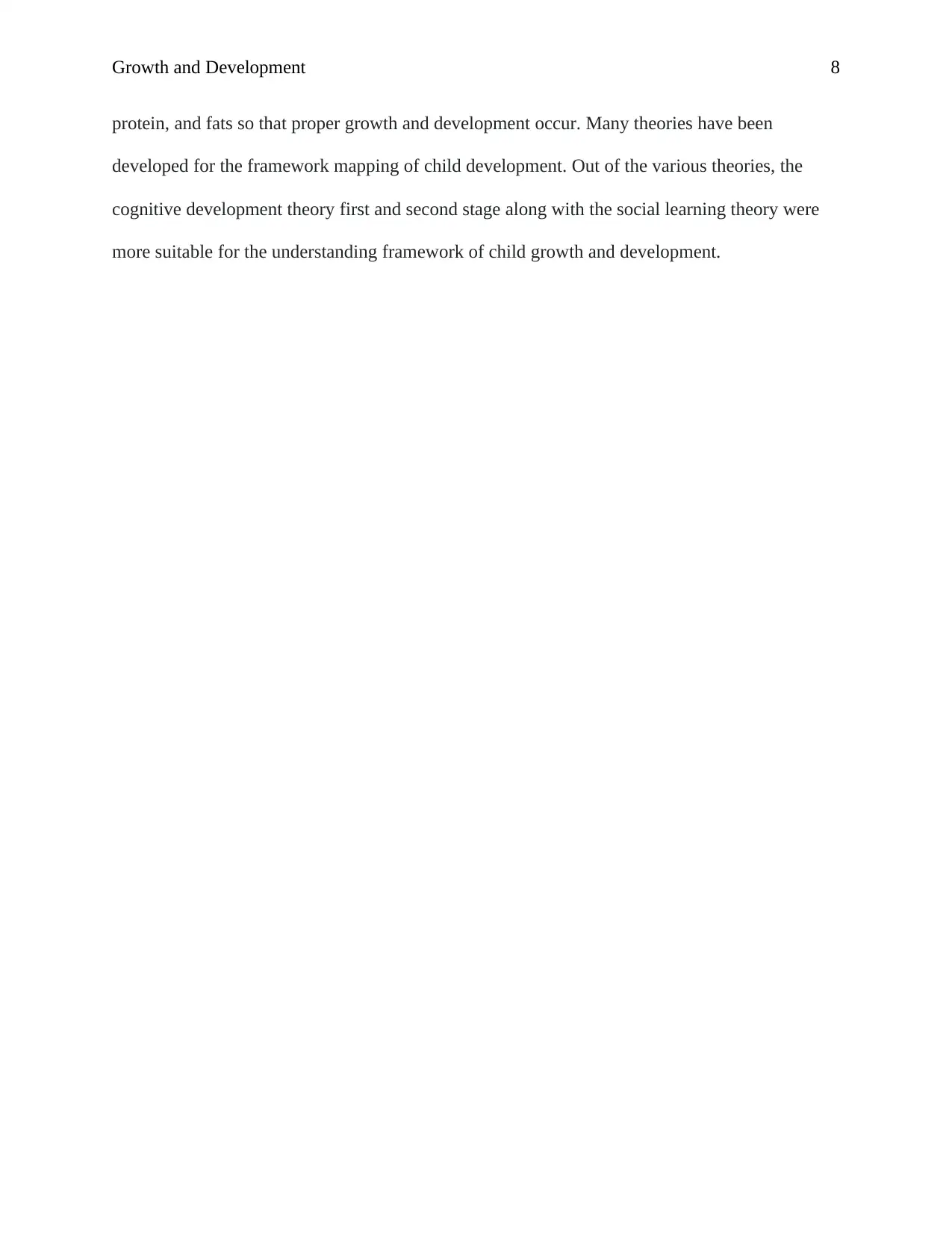
Growth and Development 8
protein, and fats so that proper growth and development occur. Many theories have been
developed for the framework mapping of child development. Out of the various theories, the
cognitive development theory first and second stage along with the social learning theory were
more suitable for the understanding framework of child growth and development.
protein, and fats so that proper growth and development occur. Many theories have been
developed for the framework mapping of child development. Out of the various theories, the
cognitive development theory first and second stage along with the social learning theory were
more suitable for the understanding framework of child growth and development.
⊘ This is a preview!⊘
Do you want full access?
Subscribe today to unlock all pages.

Trusted by 1+ million students worldwide
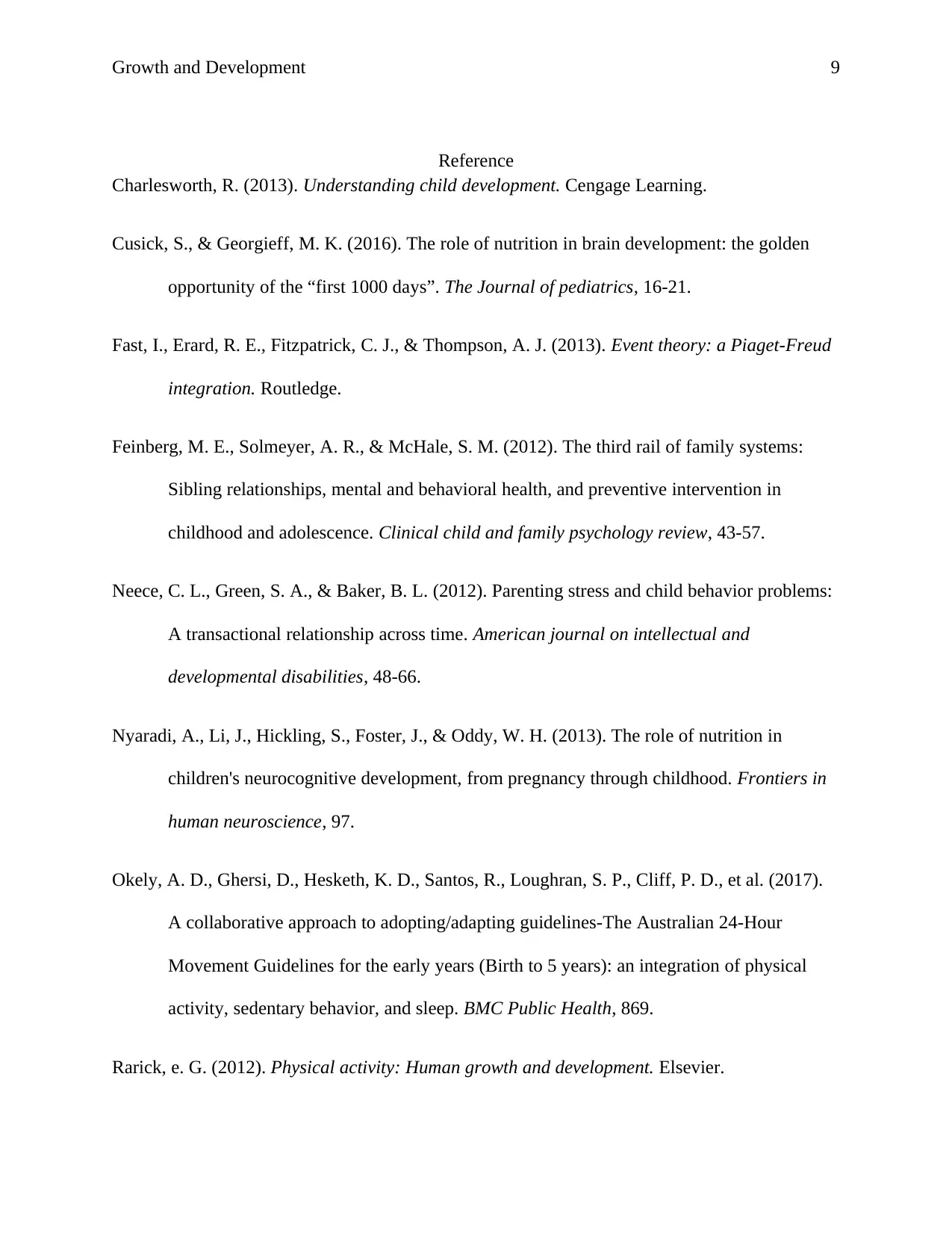
Growth and Development 9
Reference
Charlesworth, R. (2013). Understanding child development. Cengage Learning.
Cusick, S., & Georgieff, M. K. (2016). The role of nutrition in brain development: the golden
opportunity of the “first 1000 days”. The Journal of pediatrics, 16-21.
Fast, I., Erard, R. E., Fitzpatrick, C. J., & Thompson, A. J. (2013). Event theory: a Piaget-Freud
integration. Routledge.
Feinberg, M. E., Solmeyer, A. R., & McHale, S. M. (2012). The third rail of family systems:
Sibling relationships, mental and behavioral health, and preventive intervention in
childhood and adolescence. Clinical child and family psychology review, 43-57.
Neece, C. L., Green, S. A., & Baker, B. L. (2012). Parenting stress and child behavior problems:
A transactional relationship across time. American journal on intellectual and
developmental disabilities, 48-66.
Nyaradi, A., Li, J., Hickling, S., Foster, J., & Oddy, W. H. (2013). The role of nutrition in
children's neurocognitive development, from pregnancy through childhood. Frontiers in
human neuroscience, 97.
Okely, A. D., Ghersi, D., Hesketh, K. D., Santos, R., Loughran, S. P., Cliff, P. D., et al. (2017).
A collaborative approach to adopting/adapting guidelines-The Australian 24-Hour
Movement Guidelines for the early years (Birth to 5 years): an integration of physical
activity, sedentary behavior, and sleep. BMC Public Health, 869.
Rarick, e. G. (2012). Physical activity: Human growth and development. Elsevier.
Reference
Charlesworth, R. (2013). Understanding child development. Cengage Learning.
Cusick, S., & Georgieff, M. K. (2016). The role of nutrition in brain development: the golden
opportunity of the “first 1000 days”. The Journal of pediatrics, 16-21.
Fast, I., Erard, R. E., Fitzpatrick, C. J., & Thompson, A. J. (2013). Event theory: a Piaget-Freud
integration. Routledge.
Feinberg, M. E., Solmeyer, A. R., & McHale, S. M. (2012). The third rail of family systems:
Sibling relationships, mental and behavioral health, and preventive intervention in
childhood and adolescence. Clinical child and family psychology review, 43-57.
Neece, C. L., Green, S. A., & Baker, B. L. (2012). Parenting stress and child behavior problems:
A transactional relationship across time. American journal on intellectual and
developmental disabilities, 48-66.
Nyaradi, A., Li, J., Hickling, S., Foster, J., & Oddy, W. H. (2013). The role of nutrition in
children's neurocognitive development, from pregnancy through childhood. Frontiers in
human neuroscience, 97.
Okely, A. D., Ghersi, D., Hesketh, K. D., Santos, R., Loughran, S. P., Cliff, P. D., et al. (2017).
A collaborative approach to adopting/adapting guidelines-The Australian 24-Hour
Movement Guidelines for the early years (Birth to 5 years): an integration of physical
activity, sedentary behavior, and sleep. BMC Public Health, 869.
Rarick, e. G. (2012). Physical activity: Human growth and development. Elsevier.
Paraphrase This Document
Need a fresh take? Get an instant paraphrase of this document with our AI Paraphraser
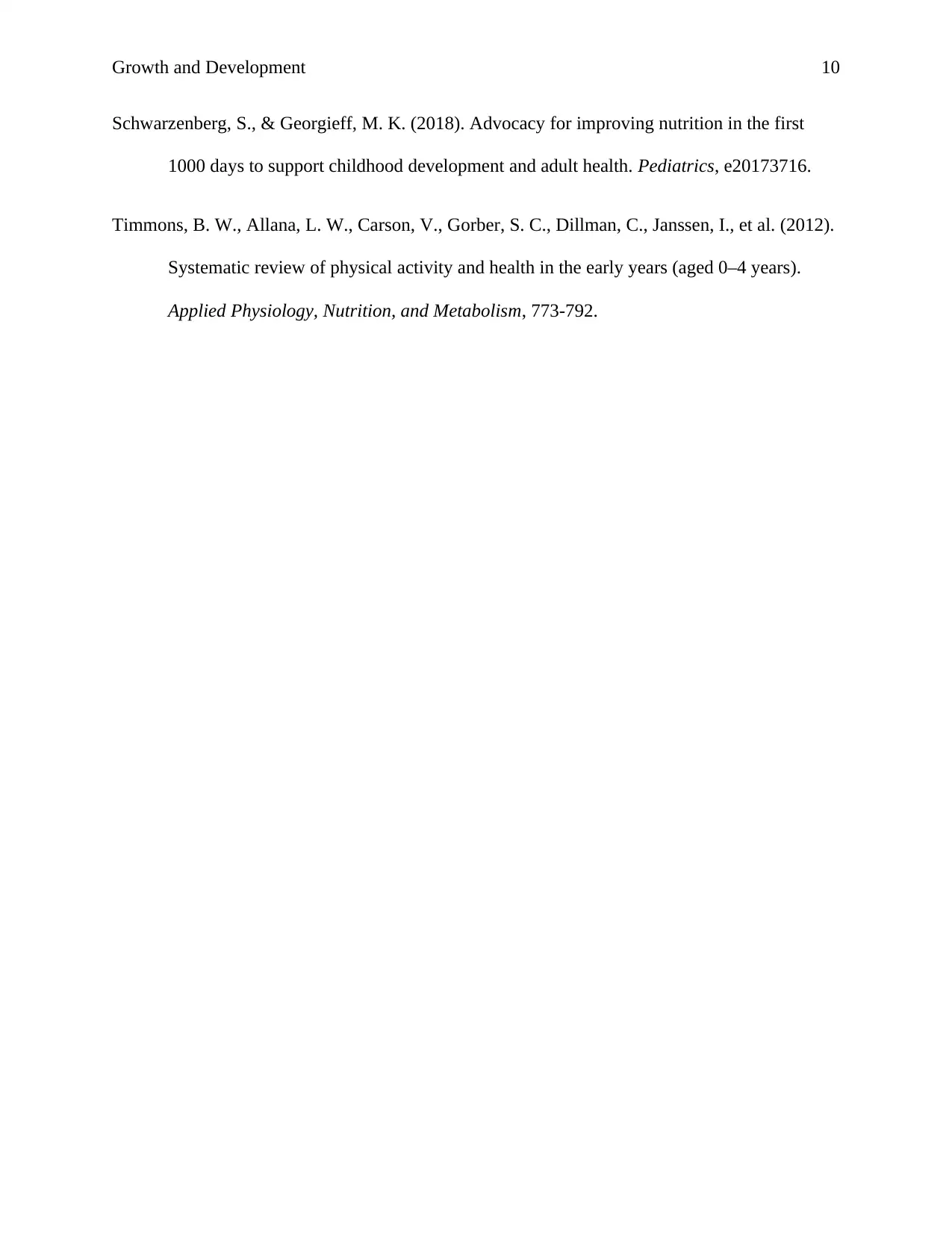
Growth and Development 10
Schwarzenberg, S., & Georgieff, M. K. (2018). Advocacy for improving nutrition in the first
1000 days to support childhood development and adult health. Pediatrics, e20173716.
Timmons, B. W., Allana, L. W., Carson, V., Gorber, S. C., Dillman, C., Janssen, I., et al. (2012).
Systematic review of physical activity and health in the early years (aged 0–4 years).
Applied Physiology, Nutrition, and Metabolism, 773-792.
Schwarzenberg, S., & Georgieff, M. K. (2018). Advocacy for improving nutrition in the first
1000 days to support childhood development and adult health. Pediatrics, e20173716.
Timmons, B. W., Allana, L. W., Carson, V., Gorber, S. C., Dillman, C., Janssen, I., et al. (2012).
Systematic review of physical activity and health in the early years (aged 0–4 years).
Applied Physiology, Nutrition, and Metabolism, 773-792.
1 out of 11
Related Documents
Your All-in-One AI-Powered Toolkit for Academic Success.
+13062052269
info@desklib.com
Available 24*7 on WhatsApp / Email
![[object Object]](/_next/static/media/star-bottom.7253800d.svg)
Unlock your academic potential
Copyright © 2020–2025 A2Z Services. All Rights Reserved. Developed and managed by ZUCOL.





